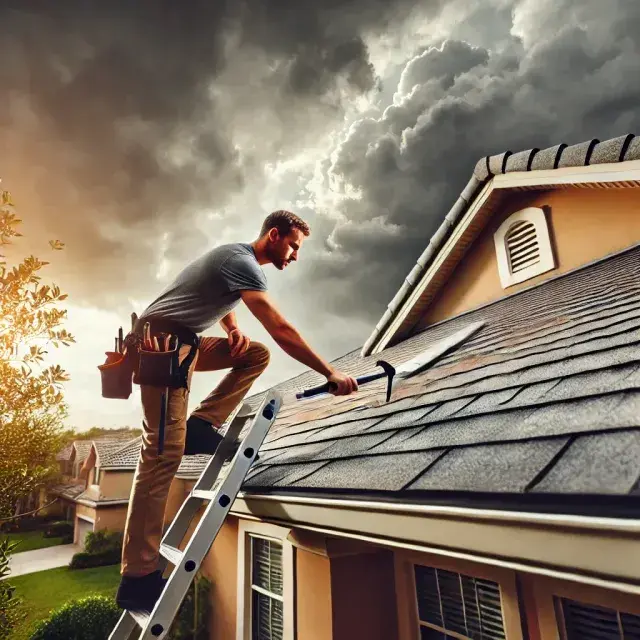Your roof protects your home when hurricanes hit. Bad roof work can cost you everything. Good roof work saves your house.
Many people try to save money on roofing. This is a big mistake during hurricane season. Your roof is your first defense against wind and rain.
Professional roofers know how to build strong roofs. They use special methods that regular people don’t know. These methods keep your roof on your house when storms come.

How Hurricanes Destroy Roofs

Hurricanes attack roofs in many ways. Wind tries to lift your roof off. Rain looks for any small hole to get inside. Flying things crash into your roof at high speed.
Here are the main ways hurricanes damage roofs:
- Wind lifts the roof – strong wind gets under shingles and pulls them off
- Things hit the roof – tree branches and debris fly around and crash down
- Water gets inside – rain finds cracks and leaks into your house
- Roof structure breaks – the wood underneath can snap or bend
- Edges come loose – corners and sides get hit the hardest by wind
- Flat roofs tear – rubber and membrane roofs can rip apart
Why You Need Professional Roofers
Regular people cannot install roofs the right way for hurricanes. Professional roofers learn special skills. They know which materials work best. They know how to attach everything properly.
Better Ways to Attach Shingles
Professional roofers use better methods than regular people:
- More nails per shingle – they use extra nails to hold things down
- Special nails – ring nails grip better than smooth nails
- Right nail placement – nails go in the exact right spots
- Seal everything – they put sealant around holes and edges
- Strong connections – everything gets attached to the main structure
- Check their work – they inspect each step to make sure it’s right
Choosing the Right Materials
Professional roofers pick materials made for hurricanes:
- Strong shingles – these can take hits from flying objects
- Wind-rated products – tested to handle specific wind speeds
- Better underlayment – extra protection under the shingles
- Good flashing – metal pieces that stop water from getting in
- Rust-proof nails – these won’t break down near the ocean
- Storm vents – these work even during bad weather
Building Rules and Laws
Areas with hurricanes have strict building rules. Professional roofers know all these rules. They make sure your roof follows the law.
Important Building Requirements
Roofers must follow these rules:
- Wind load math – they calculate how much wind your roof can handle
- Uplift resistance – enough nails and glue to fight wind suction
- Impact testing – materials must pass tests for flying debris
- Water protection – special ways to keep water out
- Air flow rules – proper ventilation that works in storms
- Inspector checks – officials must approve the work
Insurance and Warranty Benefits
Professional roof work helps with money issues:
- Lower insurance bills – many companies give discounts for good roofs
- Claims get approved – insurance pays more often for professional work
- Warranties stay valid – makers only honor warranties for professional installs
- Wind damage coverage – proper paperwork helps with claims
- Code compliance – required for full insurance protection
- Extended warranties – professional work often gets longer protection
Money Benefits of Professional Work
Professional roofing costs more at first. But it saves money in the long run. Good roofs last longer and protect better.
Ways It Saves Money
Professional hurricane roofs provide these benefits:
- Less repair costs – good roofs get damaged less in storms
- Cheaper insurance – many companies offer discounts
- Higher home value – good roofs make houses worth more
- Energy savings – better insulation and air flow
- No hotel costs – less chance of needing to leave your home
- Lasts longer – professional work holds up better over time
Reducing Your Risk
Professional roof work protects you in these ways:
- Keeps structure safe – protects your whole house from damage
- Stops water damage – prevents expensive inside repairs
- Keeps family safe – reduces chance of roof falling down
- Business keeps running – less downtime for commercial buildings
- Helps community – neighborhoods recover faster after storms
- Safer for rescue workers – secure roofs don’t create extra dangers
New Hurricane Roof Technology
Modern roofs use new technology to fight hurricanes. Professional roofers know how to install these new systems. Regular people don’t understand how they work.
Advanced Roof Systems
Professional contractors use these new technologies:
- All-in-one systems – everything works together for better protection
- Self-sealing shingles – these seal themselves when it gets hot
- Synthetic underlayment – better than old tar paper
- Hurricane clips – metal pieces that connect roof to walls
- Impact membranes – special coverings for flat roofs
- Smart materials – some roofs can tell you when they have problems
Quality Control Steps
Professional work includes these safety checks:
- Check before starting – look for problems with the house structure
- Test materials – make sure everything meets the right standards
- Check during work – inspect each step as it happens
- Final inspection – test everything when finished
- Keep records – write down everything for warranties and insurance
- Follow-up service – help with maintenance after installation
Picking the Right Roofer
Not all roofers know how to build hurricane-resistant roofs. You need to find ones with special training. Ask the right questions before you hire anyone.
What to Look For
Good hurricane roofers have these things:
- Hurricane training certificates – special classes for storm-resistant roofing
- Local licenses – proper permits to work in your area
- Insurance coverage – protects you if someone gets hurt
- Manufacturer approval – permission to install specific products
- Code knowledge – they know local building rules
- Storm experience – they have worked on hurricane damage before
Warning Signs to Avoid
Stay away from roofers who do these things:
- Knock on your door – especially after storms when people are desperate
- Very cheap prices – they will cut corners to save money
- Rush you to decide – good roofers let you think about it
- No local references – they can’t show you work they did nearby
- No written contract – everything should be written down
- Want all money first – good roofers don’t need much money upfront
Taking Care of Your Roof
Professional installation is just the start. You need to take care of your roof to keep it hurricane-ready. Professional roofers can help you with maintenance too.
Regular Check-ups
Keep your roof hurricane-ready with these steps:
- Yearly professional checks – have experts look at your roof each year
- After-storm inspections – check for damage after any bad weather
- Seasonal maintenance – fix small problems before they get big
- Gutter cleaning – keep water flowing away from your house
- Check seals and flashing – make sure water can’t get in
- Vent inspection – ensure air flows properly
Keeping Performance High
Professional maintenance keeps your roof working well:
- Fix problems early – small repairs prevent big damage
- Upgrade when possible – add better materials during repairs
- Track roof condition – keep records of any problems
- Storm preparation – get ready before hurricane season starts
- Keep paperwork – save all documents for insurance
- Stay in touch with roofer – keep contact with good contractors
Final Thoughts
Professional roof installation saves your home during hurricanes. Your roof stands between your family and the storm. Professional roofers use the right materials and methods to handle wind, rain, and debris. Good roof work protects your house and family while saving money on insurance. Don’t risk your home with amateur work. Choose qualified professionals who know hurricane roofing. The importance of professional roof installation for hurricanes grows every year as storms get stronger.






